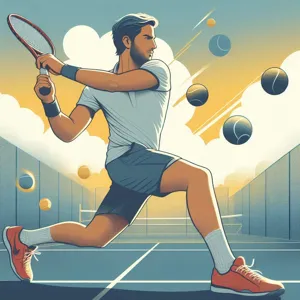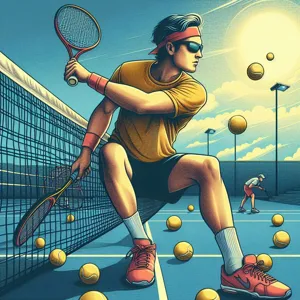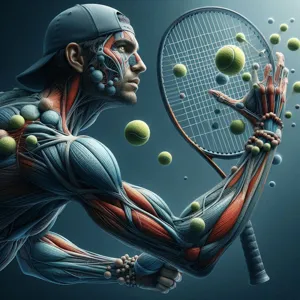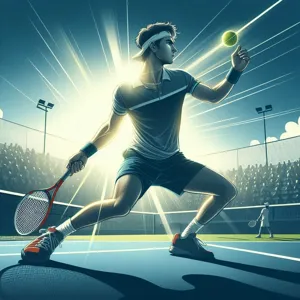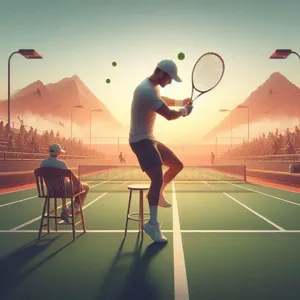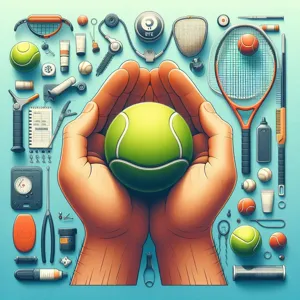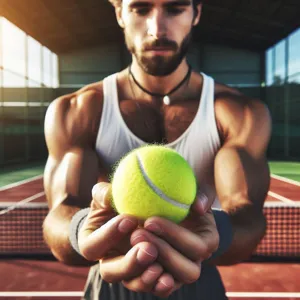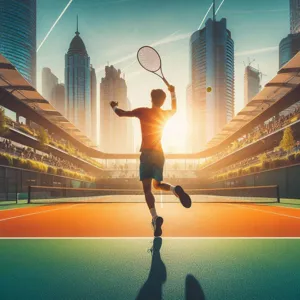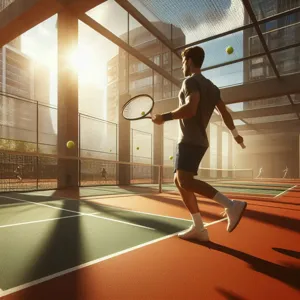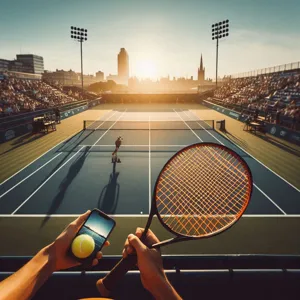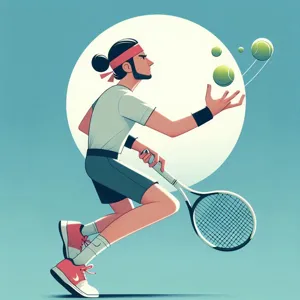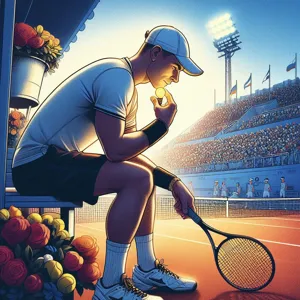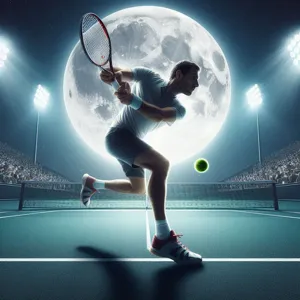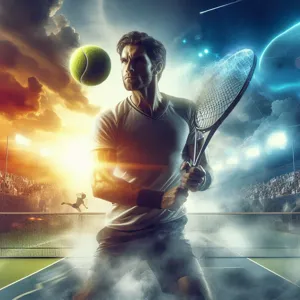In the intricate dance of tennis, where split-second decisions can determine the outcome of a match, the ability to read your opponent’s shots is an invaluable skill that can elevate your game to new heights.
Imagine standing on the court, feeling the electric tension in the air, as you anticipate your opponent’s next move with precision and confidence. Mastering this art involves more than just keen eyesight; it requires a deep understanding of your opponent’s body language, shot patterns, and tactical strategies. In this blog post, we will explore essential tips and techniques that will sharpen your instincts and improve your reaction time, allowing you to predict your opponent’s shots like a seasoned pro. Whether you’re a beginner looking to enhance your fundamental skills or an experienced player aiming to gain a competitive edge, these insights will help you navigate the court with greater awareness and agility, turning you into a formidable adversary on any playing surface. Get ready to unlock the secrets of the game and take your tennis performance to the next level!
1. Understanding the Importance of Reading Opponent’s Shots
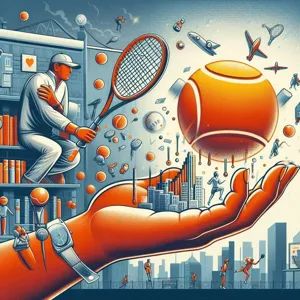
In tennis, the ability to read your opponent’s shots is akin to having a superpower on the court. It’s not just about reacting to the ball; it’s about anticipating your opponent’s intentions and making strategic decisions that can turn the tide of a match. Understanding the importance of this skill can elevate your game from average to exceptional.
When you read an opponent’s shot effectively, you gain a crucial edge. It allows you to position yourself optimally, enabling you to respond with power and precision. Whether it’s a forehand, backhand, or a drop shot, recognizing the signs of your opponent’s movement and stroke can provide invaluable insights into the trajectory and speed of the ball. This foresight gives you the split seconds needed to prepare your own shot, whether it’s a defensive lob or an aggressive winner.
Moreover, reading shots is not merely about physical preparation; it’s also a psychological game. By anticipating your opponent’s next move, you can disrupt their rhythm and instill doubt in their mind. When you consistently return their shots with confidence, they might second-guess their strategies, giving you the upper hand.
To master this skill, it’s essential to develop a keen awareness of your opponent’s habits, body language, and shot selection patterns. Observing their footwork, grip, and even their eye movements can provide clues about the type of shot they are about to deliver. The ability to read shots is not just a technical skill; it is a blend of perception, intuition, and experience that sets the great players apart from the good ones. By mastering this aspect of the game, you’ll find yourself not only reacting better but also dictating the flow of the match, ultimately enhancing your overall performance on the court.
2. Key Elements of Shot Recognition
Recognizing your opponent’s shots is crucial for gaining a competitive edge in tennis. To master this skill, you need to focus on several key elements that can enhance your ability to anticipate and react to your opponent’s movements.
**1. Body Positioning:** Pay close attention to your opponent’s stance and body positioning. The way they set up for a shot can provide valuable clues. Are they leaning back, suggesting a defensive lob, or are they poised forward, indicating an aggressive forehand? A well-trained eye can pick up on these subtleties, allowing you to predict the type of shot coming your way.
**2. Racket Angle and Grip:** The angle of your opponent’s racket at the moment of contact is another critical factor to observe. A closed racket face typically indicates a topspin shot, while an open face might signal a slice. Additionally, the grip they are using can hint at the spin and trajectory of the ball. For instance, a continental grip often results in more versatile shot options, while an eastern grip may lead to flatter strikes.
**3. Ball Toss and Swing Path:** If you’re facing a server, watch their ball toss closely. The height and placement of the toss can indicate the type of serve they’re planning—higher tosses may suggest a powerful serve, while a lower toss can indicate a more controlled shot. Similarly, analyzing the swing path can reveal whether they’re generating topspin or applying slice, enabling you to position yourself better for the return.
**4. Timing and Rhythm:** developing an intuitive sense of your opponent’s timing and rhythm can greatly enhance your shot recognition. Notice how they move during rallies—are they quick and aggressive, or do they play with a more measured approach? Understanding their tempo can help you predict their next move and prepare your response accordingly.
**5. Mental Focus:** Finally, honing your mental focus is essential for effective shot recognition. During a match, distractions can easily pull your attention away. Stay present, watch the ball closely, and keep your mind engaged. A clear and focused mindset will sharpen your observational skills, making it easier to read your opponent’s shots accurately.
By integrating these key elements into your practice and match play, you will not only improve your shot recognition but also enhance your overall performance on the court. The better you become at reading your opponent’s shots, the more confident and strategic your own game will be.
3. Analyzing Opponent’s Body Language

Understanding your opponent’s body language is a crucial skill that can significantly enhance your ability to anticipate their shots and improve your overall game. The way a player carries themselves on the court often reveals invaluable clues about their next move. Pay close attention to their stance, grip, and even facial expressions, as these subtle indicators can provide insights into their intentions.
For instance, an opponent who shifts their weight noticeably to one side may be preparing to hit a shot in that direction. Similarly, if you notice them tightening their grip on the racket, it could signal a powerful stroke is on its way. Watch for the slight rotation of their shoulders or the positioning of their feet—these physical cues can help you gauge whether they’re setting up for a slice, a topspin, or a flat shot.
Additionally, observing their eye movements can offer further hints. Players often focus their gaze in the direction they plan to hit, so if you can catch where they’re looking just before they strike the ball, you might gain a valuable second or two to react.
As you hone this skill, practice mindfulness during matches. Try to remain aware of your opponent’s movements and demeanor, rather than solely concentrating on the ball. By developing a keen sense of their body language, you can gain a competitive edge, enabling you to position yourself more effectively and respond to their shots with greater agility and precision. Remember, the court is not just a battleground for the ball; it’s also a stage for the subtle dance of strategy and psychology. Mastering the art of reading body language will elevate your game and keep your opponents guessing.
4. Observing Racket Position and Grip
### 4. Observing Racket Position and Grip
One of the most telling indicators of an opponent’s next move in tennis is the position and grip of their racket. By honing in on these subtle cues, you can gain invaluable insights into the type of shot they are about to execute, allowing you to respond more effectively and improve your overall game.
When watching your opponent, pay close attention to the height and angle of their racket. Is it held high, indicating a potential overhead smash? Or is it low and close to their body, suggesting a slice or drop shot? The slightest shift in their racket can signal their intentions, so be vigilant.
Additionally, the grip they use plays a crucial role in shot selection. A player with a continental grip is likely preparing for a serve or a volley, while an eastern or western grip can indicate a forehand or backhand stroke. Understanding these grips can help you anticipate the spin and speed of the ball. For instance, a player who shifts to a semi-western grip might be preparing for a topspin-heavy shot—this insight can prepare you to adjust your positioning accordingly.
It’s also important to observe the moment before your opponent strikes the ball. Their body language, footwork, and racket position can provide hints about their shot choice. If they lean forward and angle their racket down, they may be poised to hit a low, fast drive. Conversely, if they step back and their racket is pulled away from the body, they might be preparing for a defensive lob.
Incorporating these observations into your game can significantly enhance your ability to read your opponent’s shots. The more you practice recognizing these cues, the more instinctively you’ll respond on the court, giving you a competitive edge and allowing you to dictate the pace of the match. So, the next time you find yourself in a rally, take a moment to decode your opponent’s racket position and grip—your ability to anticipate their next move can make all the difference in securing that hard-fought point.
5. Identifying Shot Patterns and Tendencies

Identifying shot patterns and tendencies is a vital skill that can significantly elevate your performance on the tennis court. Every player develops a unique game style shaped by their strengths, weaknesses, and preferences. By keenly observing and analyzing your opponent’s shot patterns, you can predict their next move and position yourself accordingly for a strategic advantage.
Start by paying close attention during the warm-up. This is your opportunity to see which shots they favor and how they typically set up for their strikes. Do they consistently hit to one side of the court? Do they prefer topspin or slice? Do they have a go-to shot they rely on when under pressure? These initial observations can provide a wealth of information.
As the match progresses, take mental notes of their shot selections. Many players will revert to certain patterns, especially when they are stressed or trying to regain control of a point. For instance, if you notice your opponent tends to hit cross-court when they are on the defensive, you can anticipate this and position yourself for a better return. Look for trends such as how they respond to different spins, their movement patterns after serving, or their approach after winning a point.
Another effective method is to analyze your opponent’s reactions to your shots. If you hit a deep backhand and they repeatedly struggle to return it, they may begin to avoid that side altogether, revealing a potential weakness you can exploit. Additionally, consider maintaining a journal of your matches. Documenting your observations can help you recognize patterns over time, both in your opponents and in your own game.
Ultimately, mastering the ability to identify shot patterns and tendencies requires patience and practice. By honing this skill, you not only enhance your game strategy but also develop a deeper understanding of your opponent’s mindset, which can be the key to outsmarting them on the court.
6. The Role of Court Positioning in Shot Prediction
Court positioning plays a crucial role in your ability to read and anticipate your opponent’s shots in tennis. Understanding where you and your opponent are on the court can significantly enhance your predictive capabilities and put you in a better position to react effectively.
Imagine the court as a dynamic chessboard, where each movement can dictate the flow of the game. When your opponent stands closer to the net, their options for executing a shot change drastically. They might opt for a volley, which requires you to be ready to move forward and respond quickly. Conversely, if they retreat to the baseline, they’re likely preparing for a deeper, more powerful shot, perhaps even a topspin forehand that will push you back.
Observing your opponent’s footwork and body positioning is equally important. A slight shift in their stance or weight can provide significant clues about the direction and type of shot they intend to play. For example, if you notice them leaning back, they’re likely setting up for a strong, aggressive shot, while a forward lean might indicate a drop shot or a quick approach to the net.
Moreover, your own positioning on the court can influence how well you read their shots. By maintaining a balanced stance with your knees slightly bent and your weight distributed evenly, you can react more fluidly to the ball’s trajectory. Staying alert and ready to move in any direction will allow you to capitalize on the slightest hint your opponent gives away.
Incorporating effective court positioning into your training regimen not only sharpens your ability to predict shots but also enhances your overall gameplay. By mastering this aspect of tennis, you’ll find that anticipating your opponent’s next move becomes second nature, giving you a strategic edge on the court.
7. Practicing Anticipation Drills

Practicing anticipation drills is a crucial component in mastering the art of reading your opponent’s shots in tennis. The ability to anticipate not only enhances your overall gameplay but also positions you to respond swiftly and effectively to your opponent’s movements and strikes. These drills are designed to sharpen your instincts, improve your court awareness, and ultimately give you the edge in critical match situations.
Begin with simple partner drills where one player feeds balls from various positions on the court. As your partner hits, focus on observing their racket angle, body positioning, and footwork. These elements can provide vital clues about the type of shot they’re about to execute. Are they leaning back, suggesting a defensive lob, or are they poised and aggressive, signaling a powerful forehand? Reacting quickly to these signals can be the difference between a well-placed return and a missed opportunity.
To elevate the challenge, incorporate reaction drills. Use a ball machine or have a partner randomly hit balls to different areas of the court while you practice moving and hitting back with minimal hesitation. This dynamic environment will mimic real match scenarios, forcing you to read and react under pressure. Focus on predicting where the ball will land based on the angle of your opponent’s shot and your own court positioning.
Another effective drill involves “shadowing” a player. Watch a match—whether live or recorded—and try to predict each shot before it happens. Mark your thoughts on paper or discuss them with a coach or training partner. This exercise enhances your ability to foresee plays and understand the strategic intentions of players at various levels.
By consistently integrating anticipation drills into your practice regimen, you will not only improve your reaction time but also develop a deeper understanding of the game. As your anticipation skills sharpen, you will find yourself more confident on the court, ready to counter your opponent’s shots with poise and precision. Remember, tennis is not just about physical ability; it’s also a mental game where anticipation can set you apart as a formidable competitor.
8. Utilizing Video Analysis for Improvement
In the world of tennis, the ability to read your opponent’s shots can be the difference between winning and losing. One of the most powerful tools available to players today is video analysis. By harnessing the capabilities of modern technology, you can gain invaluable insights into not only your own performance but also your opponent’s tendencies and shot patterns.
Start by recording your practice sessions and matches—this can be done easily with a smartphone or a camera. Watching these videos allows you to observe your positioning, footwork, and shot selection in real-time. More importantly, you can identify moments where you struggled to read your opponent’s shots. Did they hit a powerful serve that caught you off guard? Was their drop shot unexpected? By pinpointing these instances, you can focus on specific areas for improvement.
Beyond your own gameplay, consider analyzing matches featuring players who share similar styles to your opponent. Pay close attention to how they respond to different shot types and placements. Look for patterns: do they frequently favor cross-court shots? When under pressure, do they tend to revert to defensive lobs? By studying these habits, you can anticipate their strategy and position yourself accordingly in future encounters.
Additionally, many tennis academies and coaching platforms offer advanced video analysis tools that break down match footage frame by frame, highlighting key moments and player movement. Taking advantage of these resources can provide you with a competitive edge, allowing you to develop a sharper instinct for reading your opponent’s shots.
Incorporating video analysis into your training regimen will not only refine your ability to read plays but also enhance your overall game strategy. The more data you have, the better equipped you’ll be to predict your opponent’s next move, giving you the upper hand on the court. So, grab that camera and start capturing your journey—it’s time to elevate your tennis game to new heights!
9. Learning from Professional Matches
One of the most effective ways to enhance your ability to read your opponent’s shots in tennis is to learn from the professionals. Watching high-level matches not only provides entertainment but also offers invaluable insights into the nuances of shot selection, court positioning, and tactical decisions. As you tune into these matches, pay close attention to how the pros anticipate their opponent’s moves and react accordingly.
Start by observing their body language and footwork. Professionals have a unique ability to predict their opponent’s shots based on subtle cues, such as the angle of the racket or the positioning of the feet. Notice how they position themselves on the court in response to their opponent’s stance and swing, allowing them to react quickly and effectively. This awareness is critical in developing your own anticipatory skills.
Additionally, take note of the various strategies employed during different points in the match. How do players adapt their game when facing different styles of opponents? Do they employ aggressive tactics against a baseline player, or do they play more conservatively against a net rusher? Understanding these strategies can provide you with a framework to apply during your own matches.
Consider watching matches with a specific focus. For instance, choose to analyze a particular player’s service game and see how they set up their shots based on their opponent’s weaknesses. Jot down notes on patterns you observe, and try to implement similar strategies in your practice sessions. The more you expose yourself to different playing styles and strategies, the sharper your instincts will become.
Lastly, don’t shy away from discussing these matches with fellow players or coaches. Engaging in conversations about professional play can deepen your understanding and provide new perspectives on shot anticipation. By immersing yourself in the world of professional tennis, you’ll not only stay entertained but also cultivate a more sophisticated understanding of the game, ultimately enhancing your ability to read your opponent’s shots with precision and confidence.
10. Developing Mental Focus and Concentration
In the fast-paced world of tennis, the ability to read your opponent’s shots is not just a physical skill but a mental one as well. Developing mental focus and concentration is paramount to enhancing this skill. The court can be a whirlwind of activity, with the sound of racquets striking balls and the crowd’s cheers creating a cacophony that can easily distract even the most seasoned players. To improve your shot-reading ability, you must cultivate an unwavering concentration that allows you to tune out external noise and hone in on your opponent’s movements.
Start by practicing mindfulness techniques both on and off the court. Simple breathing exercises can help clear your mind and center your thoughts before a match. Visualize your opponent’s actions as they prepare to hit the ball, paying attention to their body language and footwork. This mental visualization not only sharpens your focus but also prepares you to anticipate their next move.
Additionally, consider incorporating drills that enhance your reaction time and awareness. For instance, practice watching the ball closely during rallies, concentrating solely on its speed, spin, and trajectory. Engaging in exercises that require quick decision-making can also improve your mental agility, allowing you to process information faster during gameplay.
Moreover, maintaining a positive mindset is crucial; self-doubt can cloud your focus and hinder your ability to read your opponent. Affirmations or motivational quotes can serve as great reminders to stay composed and confident. Remember, a clear mind leads to sharper insights on the court, enabling you to predict your opponent’s shots with greater accuracy and ultimately elevating your game to new heights. By honing your mental focus and concentration, you’ll not only enhance your shot-reading abilities but also transform into a formidable competitor who can outthink and outplay opponents with ease.
11. Enhancing Peripheral Vision for Better Awareness
Enhancing your peripheral vision is a game-changer when it comes to reading your opponent’s shots in tennis. Often overlooked, this crucial aspect of visual awareness can significantly improve your on-court performance. Peripheral vision allows you to see more than just the ball; it enables you to gauge your opponent’s positioning, movements, and even their body language. By honing this skill, you can anticipate their next move and react faster, giving you a competitive edge.
To enhance your peripheral vision, start with specific exercises designed to expand your visual field. One effective drill is to focus on a central point—like a target on the wall—while being mindful of the objects around it. Gradually increase the complexity of your surroundings: incorporate distractions such as moving objects or people to simulate the dynamic environment of a tennis match. Another valuable technique is the “ball toss” drill, where you toss a tennis ball in front of you while trying to maintain focus on a distant point. This exercise trains your brain to process multiple visual stimuli simultaneously.
Incorporating these drills into your training routine will not only sharpen your peripheral vision but also enhance your overall game awareness. You’ll find that, as your visual acuity improves, your ability to read your opponent’s shots will become more intuitive. This heightened awareness will enable you to position yourself more effectively on the court, making it easier to respond to powerful serves or strategic volleys. Ultimately, mastering your peripheral vision will transform you into a more agile and responsive player, ready to take on any challenge that comes your way.
12. Communicating with Your Coach for Insight
Effective communication with your coach can be a game-changer when it comes to enhancing your ability to read your opponent’s shots in tennis. Your coach serves as your strategic partner, possessing a wealth of experience and insight that can provide invaluable guidance both on and off the court. By fostering a strong dialogue, you can gain deeper insights into your opponent’s playing style, strengths, and weaknesses, allowing you to anticipate their next move with greater accuracy.
During practice sessions, take the time to discuss specific scenarios with your coach. Ask them to observe your opponent’s patterns and tendencies, and encourage them to share their observations with you. For instance, they might point out that your opponent tends to hit a particular shot with a specific grip or stance, or that they struggle with certain types of shots when pressured. This knowledge can help you develop strategies and mental cues to watch for during your matches.
Additionally, utilize post-match debriefs with your coach to analyze your performance. Discuss what you noticed while playing, what worked, and where you felt challenged. Your coach can help you connect the dots between your observations and the tactical adjustments needed for future matches. This collaborative approach not only sharpens your ability to read the game but also strengthens your overall strategic thinking.
Remember that effective communication is a two-way street. Be open to feedback and willing to share your thoughts, as this will create a more dynamic learning environment. The more you engage with your coach, the better prepared you will be to anticipate your opponent’s shots and respond accordingly, giving you the edge you need to master the game.
13. Adapting Strategies Based on Opponent’s Style
Adapting your strategies based on your opponent’s style is a crucial skill that can elevate your tennis game to new heights. Every player brings a unique set of strengths, weaknesses, and playing styles to the court, and recognizing these traits can provide you with a significant advantage.
To begin with, take note of your opponent’s preferred shot types. Are they aggressive baseliners who thrive on powerful groundstrokes, or do they favor a more strategic approach, employing drop shots and slices to disrupt your rhythm? Observing their tendencies will allow you to anticipate their next move and adjust your positioning accordingly. For instance, if you’re facing a player with a powerful forehand, you might want to adopt a more defensive stance, ready to return those aggressive shots with precision and timing.
Additionally, pay attention to your opponent’s footwork and court coverage. Do they struggle with lateral movement, or are they quick on their feet? If you spot a vulnerability in their mobility, you can exploit it by directing your shots toward the corners of the court, forcing them to stretch and potentially miss the ball.
Moreover, consider the mental aspect of your opponent’s game. Some players become flustered under pressure, while others thrive in high-stakes situations. If you notice signs of frustration, such as a change in their body language or an increase in unforced errors, it may be time to ramp up your aggression and dictate the pace of the match.
Lastly, don’t be afraid to switch up your own strategy mid-game. Tennis is as much a mental battle as it is a physical one, and being adaptable can keep your opponent guessing. If you started the match playing aggressively but notice your opponent has found their rhythm, consider mixing in more slices or drop shots to break their momentum.
By keenly observing and adapting your strategies based on your opponent’s style, you arm yourself with the tools needed to outmaneuver them on the court, turning the tide in your favor and ultimately enhancing your overall performance.
14. The Importance of Patience and Timing
In the fast-paced world of tennis, where every split second can make or break a point, the virtues of patience and timing often take a backseat to raw athleticism and aggressive play. However, mastering these two elements is crucial for any player looking to elevate their game and outsmart their opponents. Patience in tennis is more than just waiting for the perfect moment; it’s about understanding the rhythm of the match and recognizing when to engage and when to hold back.
When you’re on the court, it’s easy to get caught up in the excitement of the game. A powerful serve or a deep forehand might tempt you to rush your response. Yet, the most successful players know that taking a moment to assess the situation can lead to a more advantageous shot. Watch your opponent’s body language, the angle of their racket, and the position on the court. These subtle cues can provide invaluable information about their next move, allowing you to position yourself effectively and respond with precision.
Timing, on the other hand, is about syncing your movements with your opponent’s actions. It’s crucial to anticipate the moment when your opponent makes contact with the ball. A well-timed reaction can be the difference between returning a shot with power or simply getting it back over the net. Think of it as a dance; the more you tune into the rhythm of the game, the better you’ll be at predicting your opponent’s shots.
Incorporating patience and timing into your practice sessions can significantly enhance your ability to read shots. Drill scenarios where you focus solely on observing your opponent rather than just reacting. This not only sharpens your instincts but also instills a sense of calm under pressure. Remember, it’s not just about hitting the ball; it’s about setting yourself up for success with every shot. By cultivating these qualities, you’ll find that not only does your game improve, but you also gain a competitive edge that can make all the difference on the court.
15. Conclusion: Continuous Improvement in Shot Reading Skills
In conclusion, the journey to mastering the art of reading your opponent’s shots in tennis is one of continuous improvement and refinement. Just like any skill in the sport, the ability to anticipate and react to your opponent’s moves requires a commitment to practice and a keen awareness of the game. As you integrate the techniques and strategies discussed throughout this guide, remember that consistency is key.
Start by incorporating specific drills into your training regimen that focus on shot recognition and reaction time. Observing opponents during matches, both in person and through video analysis, can also offer invaluable insights into their patterns and tendencies. The more you expose yourself to different playing styles, the better equipped you’ll be to anticipate shots and respond accordingly.
Moreover, don’t underestimate the power of mental preparation. Visualization techniques can enhance your ability to read the game, allowing you to mentally rehearse various scenarios and develop a stronger instinct on the court. Keep a journal of your matches to track your progress and reflect on which strategies worked or need adjustment.
As you embrace this process of continuous improvement, you’ll find that your shot-reading skills will not only enhance your overall game but also boost your confidence on the court. Tennis is as much a mental game as it is a physical one; mastering the nuances of shot reading will give you a competitive edge over your opponents. So, lace up those shoes, step onto the court, and commit to honing this vital skill—your game will thank you for it!
In conclusion, mastering the art of reading your opponent’s shots in tennis is a skill that can significantly elevate your game and give you a competitive edge on the court. By implementing the tips we’ve shared—such as honing your observation skills, anticipating ball trajectories, and understanding your opponent’s tendencies—you can become more attuned to the rhythm of the match and respond more effectively to your opponent’s moves. Remember, practice is key; the more you play and analyze each match, the sharper your instincts will become. So lace up your shoes, grab your racquet, and get out there—every match is an opportunity to enhance your skills and enjoy the beautiful game of tennis. Happy playing!


